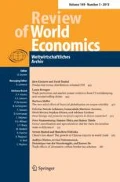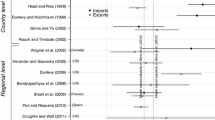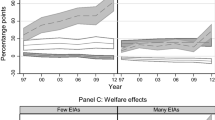Abstract
Using data on the levels of economic integration agreements (EIAs) among 172 countries (35 OECD members and 137 non-members) that span the years 1995–2009, we examine the effects of immigrants and EIA levels on bilateral trade costs between immigrants’ host and home countries and whether the influence of immigrants on trade costs varies across types of EIAs. Results obtained from the estimation of a series of augmented gravity specifications using the multi-level mixed effects model (random intercepts and coefficients) indicate that increases in the level of EIA and in the stock of immigrants are associated with declines in bilateral trade costs (measured both at the aggregate level and across sectors). However, the trade costs-reduction effect of immigrants varies non-linearly with the extent to which their host and home countries are integrated. While heterogeneous across country pairs, the effect of immigrants on trade costs remains strong even among country pairs at the peak EIA level, implying that the effects of immigrants on international economic interactions is both expansive and broader than often understood.
Similar content being viewed by others
Notes
For example, the foundation for the European Monetary Union (EMU) was laid in 1957 when Belgium, France, Italy, Luxembourg, the Netherlands, and West Germany formed the European Economic Community (EEC). However, over the next five decades, the EEC added nine members and twice changed its name—to the European Community in the 1970 s and to the European Union in 1993—culminating in the formation of the EMU in 1999. Similarly, in 1967 the Association of Southeast Asian Nations (ASEAN) was created by Indonesia, Malaysia, the Philippines, Singapore, and Thailand. In the years since, Brunei, Cambodia, Laos, Myanmar, and Vietnam have joined. Likewise, the Asia-Pacific Economic Cooperation (APEC) was founded in 1989 by 12 countries as an informal forum. It now has 21 member economies on both sides of the Pacific Ocean. The Common Market of the South (MERCOSUR) was established in 1988 as a regional trade agreement between Brazil and Argentina. It expanded in 1991 to include Uruguay and Paraguay, and more recently, Bolivia, Chile, Colombia, Ecuador, and Peru have become associate members while Venezuela remains engaged in the membership process. The Cooperation Council for the Arab States of the Gulf (GCC) was created in 1981 by Bahrain, Kuwait, Oman, Qatar, Saudi Arabia, and the United Arab Emirates. While its membership has not expanded, the GCC has evolved to be as much a political organization as an arbiter of trade and economic and social issues. Lastly, the African Economic Community (AEC), an organization of the African Union, promotes development among member states. Created in 1991 and fully implemented in 1994, the AEC provides staged integration of members by fostering the creation of a free trade zone, customs union, shared currency, and eventual economic and monetary union.
The index ranges from 0 (i.e., not at all integrated) to 100 (i.e., highly integrated).
While we examine associations between variables, it is important to note that relationships may be non-causal.
Data on EIAs are available for 182 countries and longer two additional years; however, our sample used in the main analysis is limited to 172 countries: 35 OECD (host and home) countries and 137 home only countries for which data on bilateral trade costs and stocks of immigrants are available.
Similar to immigrants exerting a positive influence on trade flows by reducing trade costs, Tadesse et al. (2017) find that aid-for-trade (AFT) inflows contribute to reductions in bilateral trade costs faced by AFT recipients.
While data on EIAs is available for the period from 1995 through 2011, our analysis is limited to 1995–2009 due to a lack of data on the depth of EIAs post-2009.
The geographic regions are Africa, Asia, Europe, the Pacific, and the Americas.
Trade costs generally arise from two main sources. First, the bilateral factors of separation between the exporter and the importer countries, often dependent on exogenous factors (e.g., geographical distance, language, common history, or sharing a common border, etc.). Second, endogenous factors representing the ‘thickness’ of the two countries’ borders (e.g., logistics such as cost, delay, and reliability; trade facilitation bottlenecks, such as border control, and transit systems with third countries) and international connectivity, tariffs and non-tariff measures. Showing that the approach often used by applied international trade literature in estimating trade costs fails to produce accurate estimate of the level of trade costs and suffers from omitted variables bias, Novy (2013) uses an inverse form of the gravity model to estimate bilateral trade costs observed from the pattern of trade and production across countries. Using information obtained from the U.N. ESCAP (Economic and Social Commission for Asia and the Pacific) and the World Bank for relevant variables, Arvis et al. (2013) provides bilateral trade cost estimates. The database is available at http://data.worldbank.org/data-catalog/trade-cost.
EIAs generally include a phase-in period during which provisions of the treaty gradually take effect. They are thus likely to have lagged effects on trade; hence, our use of lagged EIA values.
Internal distance, when k = j, is calculated as \(0.4 \times \sqrt {Land Mass_{i} }\) (Head and Mayer 2000).
Given the log-transformed values of the dependent variable series, the corresponding effects of each of the dummy variables is estimated as [exp(βi) − 1] ×100.
We repeat these estimations by substituting, in turn, using sector-specific measures of bilateral trade costs (i.e., for manufactured and agricultural goods). Table 7 presents results related to the costs of trading manufactured goods, while Table 8 presents results associated with the cost of trading agricultural goods. In both sectors, the pattern of coefficient magnitudes, signs, and statistical significance generally mirror the results in Table 2 where the dependent variable series is total bilateral trade costs. Focusing on our variables of primary interest (i.e., the immigrant stock and EIA variables), we find that all else equal, depending on the specification considered, a one percent increase in the stock of immigrants decreases the costs of trading manufactured goods by 0.0289 percent to 0.0299 percent and the cost of trading agricultural goods by 0.0243 percent to 0.0254 percent. Being a party to a preferential trade agreement (i.e., the presence of an EIA, without specifying the type/form) reduces the bilateral trade costs faced by the typical home country in our study with that of the typical OECD member country by 10.1 percent for manufactured goods and by 9.92 percent for agricultural goods.
This may arise from horizontal or vertical expansion of the EIA or both.
We present marginal effects for contemporaneous, 1-year lag, and 5-year lags of levels of EIAs. Across all specifications, the effects of the variables of interest remain statistically significant, with minor variation. Consistent with observations from Baier and Bergstrand (2007), our results show that both the effects of EIAs and immigrants tend to be higher the longer the lags, particularly at the aggregate level and for agricultural goods. For trade costs involving manufactured goods, however, the longer the lags, the effects tend to decline, although not across the board. Thus, while we report estimation results from all three specifications for reference, given our primary objective of examining whether the effects of EIAs vary by level of EIAs, our discussion uses results from 1-year lag of the levels of EIAs.
While we fail to reject the equality of the coefficients of the lower three levels of EIAs, not only is equality between the corresponding coefficients of the highest three levels of EIAs rejected at p < 0.01, the coefficients are found to be significantly higher than the coefficients of each of the lowest three levels of EIAs.
For example, the effect of membership in a preferential trade bloc on trade costs is expected to be uniform across all members. While FTA members continue to have different national external tariffs, a uniform external tariff is the default trade policy for those that are in custom unions (even as non-tariff barriers remain inherently discriminatory).
Given that our cohort of home countries includes both developed and developing countries, it is possible that the effects may vary. To consider such a possibility, we modify our specification by including a term that interacts a dummy variable that takes a value of 1 if the home country is a developed country and is equal to 0 otherwise with the immigrant stock variable. Our results show that, all else constant, the effects of immigrants from developed countries on bilateral trade costs is marginally lower than that of the effects of immigrants from developing home countries, on average. Given the double logarithmic nature of the specification, we find that a 1% increase in the stocks of immigrants from a developed home country, on average, reduces bilateral trade costs by 3.04%. The effects of a corresponding increase in the stocks of immigrants from developing countries is 3.61%.
These observations remain consistent irrespective of whether we allow only two-way interactions between EIAs and depth of integration or three-way interactions among the levels of EIA, depth of integration, and stocks of immigrants.
The BLUPs for these countries are negative and statistically significant, indicating the extent to which the home country-specific effects exceed the average reported from the entire sample.
Tables 9 and 10 present the BLUPs for manufactured goods and agricultural trade costs, respectively. Examining corresponding results for the manufactured goods sector, we find effects of immigrants that mirror the results reported for total trade costs. In 79 countries, the home country-specific effects are equivalent to the average effect for the entire sample; in 44 countries, the corresponding effects are higher than the overall average. In another set of 44 countries, the effects that are lower than the full sample average, including 20 home countries for which the observed effects are not statistically different from zero. When considering the costs of trading agricultural goods, we find 71 countries for which the estimated effects are not significantly different from the overall average effect; 52 countries for which the corresponding effects are significantly higher than the full sample average, and 47 home countries for which the effects are significantly lower. For a considerable number of these instances (i.e., 36 countries), the home country-specific effects are not statistically discernible. The BLUPs for Guinea-Bissau, Guyana, Lesotho, Liberia, and Micronesia (manufactured goods trade costs) and Lesotho (agricultural goods trade costs) are missing as a result of data on trade costs either at aggregate or sector levels not being available.
A policy-relevant extension of this observation might be future research examining trends in the observed pattern of the influence of immigrants on bilateral trade flows (trade costs) over time.
Given the variation in the observed effects, future research focusing on the causes of the variation is important. Although not directly on trade costs, Tadesse and White (2011) and White and Tadesse (2011) examine related issues on bilateral trade flows across home countries and migration corridors, respectively.
Table 11 presents estimation results for Heckman selection model.
Table 12 presents average marginal effects, obtained using the mixed effects estimation approach, while aggregating the three highest levels of EIAs (i.e., Customs Union, Common Market, and Economic Union).
References
Anderson, J. E., & van Wincoop, E. (2003). Gravity with gravitas: A solution to the border puzzle. American Economic Review, 93(1), 170–192.
Arvis, J., Duval, Y., & Utoktham, C. (2013). Trade costs in the developing world: 1995–2010 (World Bank Policy Research Working Paper No. 6309). The World Bank, Washington, D.C.
Baier, S., & Bergstrand, J. (2007). Do free trade agreements actually increase members’ international trade? Journal of International Economics, 71(1), 72–95.
Baier, S., Bergstrand, J., & Clance, M. (2017). Heterogeneous economic integration agreements’ effects, gravity, and welfare. Research paper series on political economy of globalization (Research Paper 2017/05).
Baier, S., Bergstrand, J., & Feng, M. (2014). Economic integration agreements and the margins of international trade. Journal of International Economics, 93(2), 339–350.
Bergstrand, J. (2017). Database on economic integration agreements. https://www3.nd.edu/~jbergstr/. Accessed April, 2017.
Centre d’Etudes Prospectives et d’Informations Internationales (CEPII). (2017). Gravity dataset. http://www.cepii.fr/CEPII/en/bdd_modele/presentation.asp?id=8. Accessed April 1, 2017.
Dreher, A., Gaston, N., & Martens, P. (2008). Measuring globalization—Gauging its consequences. New York: Springer.
Dür, A., Baccini, L., & Elsig, M. (2014). The design of international trade agreements: Introducing a new database. Review of International Organizations, 9(3), 353–375.
Duval, Y. Neufeld, N., & Utoktham, C. (2016). Do trade facilitation provisions in regional trade agreements matter? Impact on trade costs and multilateral spillovers. Asia-Pacific research and training network on trade (ARTNeT) (Working Paper Series 164).
Freeman, R., & Pienknagura, S. (2016). Are all trade agreements equal? The role of distance in shaping the effect of economic integration agreements on trade flows (World Bank Group, Policy and Research Working Paper #7809).
Gaston, N., & Nelson, D. (2013). International migration. In D. Bernhofen, R. Falvey, D. Greenaway, & U. Kreickemeier (Eds.), Palgrave handbook of international trade. London: Palgrave Macmillin UK.
Genc, M. (2014). The impact of migration on trade. IZA World of Labor. https://doi.org/10.15185/izawol.82.
Goldberg, P., & Pavcnik, N. (2016). The effects of trade policy. In K. Bagwell & R. W. Staiger (Eds.), The handbook of commercial policy. Amsterdam: Elsevier.
Head, K., & Mayer, T. (2000). Non-Europe: The magnitude and causes of market fragmentation in Europe. Weltwirtschaftliches Archiv/review of World Economics, 136(2), 285–314.
Head, K., & Ries, J. (1998). Immigration and trade creation: Econometric evidence for Canada. Canadian Journal of Economics, 31(1), 47–62.
Novy, D. (2013). Gravity redux: Measuring international trade costs with panel data. Economic Inquiry, 51(1), 101–121.
Organization for Economic Co-operation and Development (OECD). (2017). International migration database. http://www.oecd-ilibrary.org/statistics. Accessed September, 2017.
Rabe-Hesketh, S., & Skrondal, A. (2008). Multilevel and longitudinal modeling using stata (2nd ed.). College Station, TX: Stata Press.
Tadesse, B., Shukralla, E., & Fayissa, B. (2017). Are bilateral and multilateral aid-for-trade complementary? The World Economy, 40(10), 2125–2152.
Tadesse, B., & White, R. (2011). Emigrant effects on bilateral trade: Reexamining the immigrant-trade link from the home country perspective. The Eastern Economic Journal, 37(2), 289–310.
Tadesse, B., & White, R. (2015). Do immigrants reduce bilateral trade costs? An empirical test. Applied Economics Letters, 22(14), 1127–1132.
Tadesse, B., & White, R. (2017). Immigrants, cultural differences, and trade costs. International Migration, 55(1), 51–74.
White, R., & Tadesse, B. (2011). International migration and economic integration: Understanding the immigrant-trade link. Cheltenham, UK: Edward Elgar Publishing.
World Bank. (2017). World development indicators. http://data.worldbank.org/data-catalog/world-development-indicators. Accessed May 1, 2017.
Author information
Authors and Affiliations
Corresponding author
Additional information
Publisher's Note
Springer Nature remains neutral with regard to jurisdictional claims in published maps and institutional affiliations.
Appendix
Appendix
Tables 7, 8, 9, 10, 11 and 12.
About this article
Cite this article
Tadesse, B., White, R. Economic integration agreements, immigrants and trade costs. Rev World Econ 155, 353–406 (2019). https://doi.org/10.1007/s10290-019-00339-0
Published:
Issue Date:
DOI: https://doi.org/10.1007/s10290-019-00339-0




